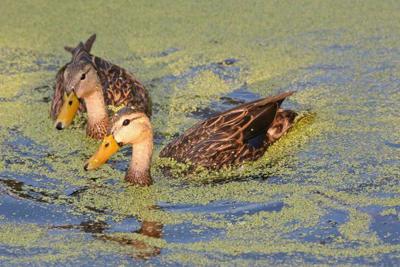The mottled duck is looking for love in all the wrong places.
As its breeding grounds disappear along the Louisiana coast, the mottled duck -- the only duck native to the marshes of the American South -- is finding mates farther inland, in urban drainage and park ponds, ditches and farm fields. Problem is, that's increasingly the territory of the mallard, the most common and widespread duck in the world.
Pushed together by the coast's land loss crisis, the two closely-related species are interbreeding, resulting in a hybrid that will eventually look and act more like the dominant mallard and less like the mottled duck.
"It's a unique species to the Gulf coast, separated (from other species) over millions of years of evolution," said waterfowl biologist Robert Ford, referring to the mottled duck. "Whereas, the mallard is ubiquitous. It's invading the whole United States."
Ford is the lead author of a new Louisiana State University study that links the loss of coastal habitat with a rise in mallard crossbreeding. His research, published in the journal Condor: Ornithological Applications, draws from the genetic testing of more than 400 ducks. Only about 5 to 8 percent showed hybridization, but that number is expected to rise as Gulf marshes recede, Ford said.
Louisiana's coast is disappearing at a rate of a football field every 100 minutes, according to calculations by the U.S. Geological Survey. Over the past 80 years, the state has lost about 2,000 square miles of coastal wetland due to several factors, including erosion from oil and gas canals, natural subsidence, hurricanes and the construction of Mississippi River levees, which prevent land-building sediment and nutrients from reaching swamps and marshes.
Mottled ducks evolved to fill a niche in the Gulf coast ecosystem. They don't migrate, staying put year-round in pairs or small groups. Unlike male mallards, which have iridescent green heads, male mottled ducks look nearly identical to their female counterparts.
Louisiana Audubon lists the bird as a "species of concern," mostly due to the rapid loss of habitat.
"It had a small population size to begin with," said Erik Johnson, Audubon Louisiana's director of bird conservation. "And now there's probably less than 100,000 of the species. The mallard, in contrast, has millions and millions and millions."
Hunters are having little impact on the mottled duck, Johnson said. That may be partly due to the fact they're hard to shoot. Ellis Guilbeau, chairman of the Louisiana chapter of Ducks Unlimited, said mottled ducks are more wary of hunters. They also know how to hide in the marsh better than migratory ducks.
"The migratory birds don't know what to do," he said. "They're all over the place."
Mallards typically steer clear of the Gulf's coastal marshes. When mallards do overlap into mottled duck territory, their out-of-synch mating habits usually inhibit crossbreeding. Mottled ducks are paired up with their own species by the time migratory mallards drop by in late November. But it's not the migratory mallards that are the biggest concern. The mallard that mottled ducks are more likely to encounter in inland ponds are the domesticated variety. Reared on farms, these mallards don't have the will to migrate, and can easily synch with the mottled duck's breeding cycle.
Thousands have gone "feral" after release or escape from farms and hunting reserves.
In Florida, about 12,000 domesticated mallards have been released each year since the early 1990s, according to Ford. Louisiana has at least two hunting reserves that release farm-raised mallards for hunters to shoot.
"But not all of them get shot," Ford said.
Feral mallards have become year-round residents in the inland areas that are now also a place of refuge for mottled ducks fleeing the eroding coast.
Mallards apparently give them warm welcome.
"They're a very promiscuous species," Johnson said. "They interbreed with a lot of things."
Mallards are flooding the gene pools of other localized breeds in the U.S. The American black duck of the north Atlantic states and the Mexican duck of the American southwest are hybridizing with the mallard. In some cases, the mallard has bred other species out of existence. New Zealand's Pacific black duck "was most likely eliminated" by mallard crossbreeding, according to Ford.
"If this continues, there'll be just one super species," Ford said.
Tristan Baurick covers Louisiana's coastal environment for NOLA.com | The Times-Picayune. Email: tbaurick@nola.com * Twitter: @tristanbaurick * Facebook: Tristan Baurick and Louisiana Coastal Watch.

